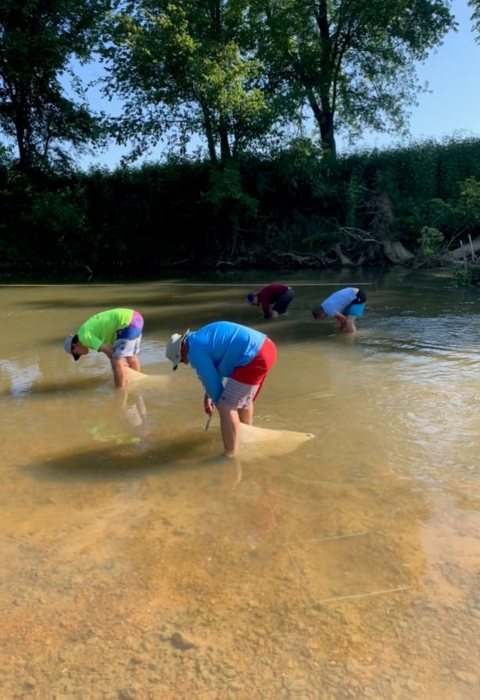On August 16th and 17th, Norfork National Fish Hatchery employees assisted malacologist, Kendal Moles and other Arkansas Game and Fish Commission employees with a mussel survey on the Spring River. Arkansas Tech University brought a few students to the survey as well. The survey was done using a randomized quadrat sampling method. In simpler terms, individual squares of the site's river bottom were selected and sampled. This required select quadrats to be dug out and placed into sediment bags. That is what most of the hatchery employees spent their time on. The digging was tiring work, but it was also a good opportunity to learn new mussel species that aren’t propagated at the hatchery. Many of the mussels were laying on top of the river bottom and were easy to spot within a quadrat. Others were completely covered by sand ,grave, etc. Only one sediment bag was used for each quadrat. Once a sediment bag was adequately filled, the substrate was sorted through and recorded. After mussels were identified and measured, they were spread out and returned to sample site.
There was an abundance of species at the sampling site. It is always a good sign when mussels are visible on the river bottom in every direction. Over twenty species of muscles were collected during the survey. Some of the notable species that were sampled include the snuffbox, rabbitsfoot, butterfly, and fanshell mussel species. All of these are currently being propagated (reproduced from brood stock) or are potential candidates for the future. In fact, that sampling site is where many of the hatchery's brood mussels have come from over the past few years. During the sample, there were even a few female rabbitsfoot mussels collected. Many of the mussels propagated at the hatchery end up in the Spring River at sites similar to the survey site. Getting to experience a population of mussels like that of the Spring River site brings a great deal of pride. The Norfork National Fish hatchery and other hatcheries/ project offices are helping to bring those populations back.
Overall, it was a great break from everyday work and a good way to get more involved in the mussel work done by the hatchery. In the past, host fish collection, infestation, and rearing of host fish and juvenile mussels, was the only mussel work the hatchery was directly part of. Knowing more about what goes into both the decision making behind propagation and what makes it possible for hatcheries is important to overall success. Collaborations like this are great ways to increase the trust between partners and share the workload on projects like mussel propagation. Plus, the sampling was a lot of fun!



